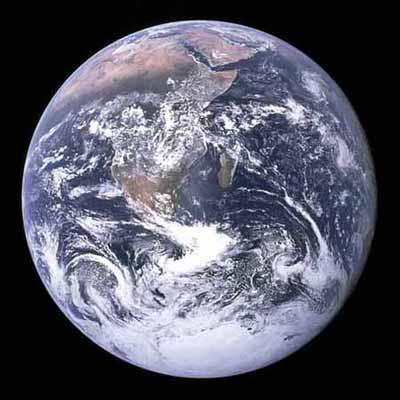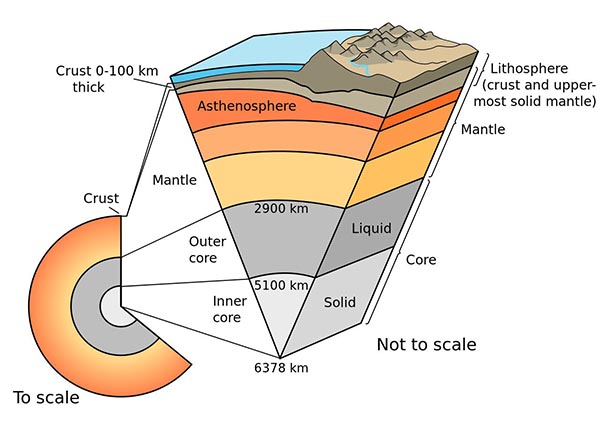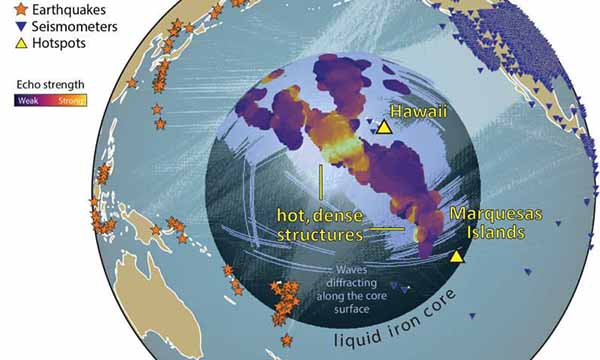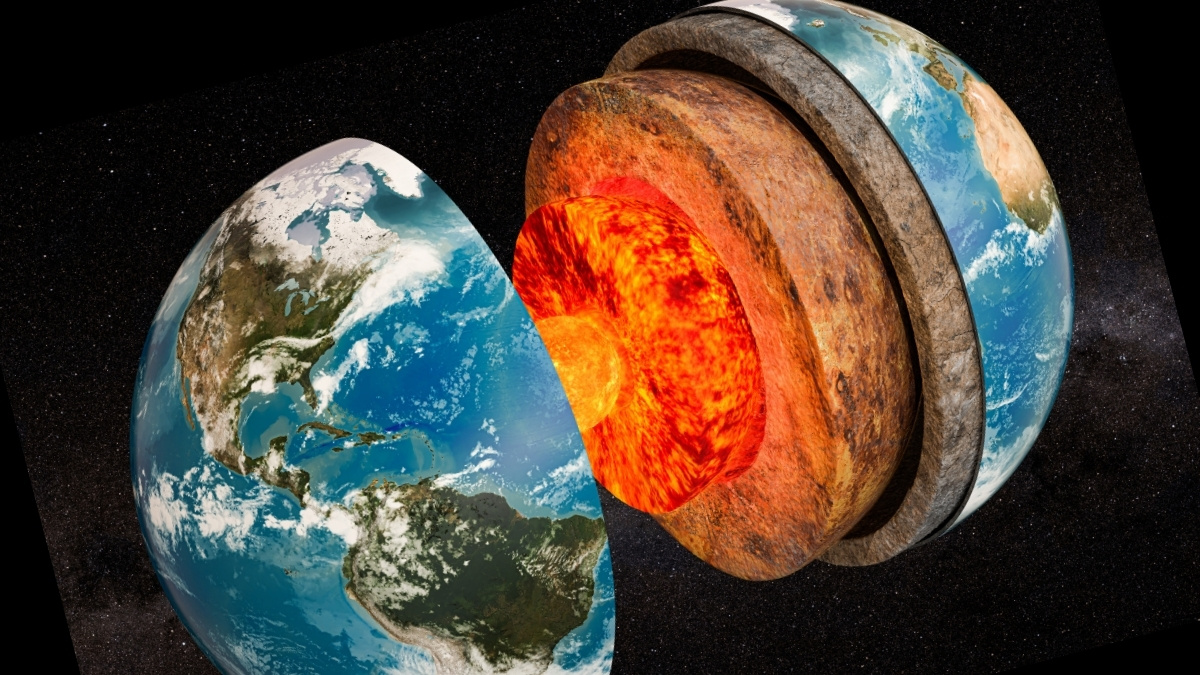

Earth is the third planet from the Sun and the only astronomical object known to harbor life. According to radiometric dating estimation and other evidence, Earth formed over 4.5 billion years ago.
Earth's gravity interacts with other objects in space, especially the Sun and the Moon, which is Earth's only natural satellite. Earth orbits around the Sun in 365.256 solar days, a period known as an Earth sidereal year. During this time, Earth rotates about its axis 366.256 times, that is, a sidereal year has 366.256 sidereal days.
Earth's axis of rotation is tilted with respect to its orbital plane, producing seasons on Earth. The gravitational interaction between Earth and the Moon causes tides, stabilizes Earth's orientation on its axis, and gradually slows its rotation. Earth is the densest planet in the Solar System and the largest and most massive of the four rocky planets. Read more ...

Earth's outer layer (lithosphere) is divided into several rigid tectonic plates that migrate across the surface over many millions of years. About 29% of Earth's surface is land consisting of continents and islands. The remaining 71% is covered with water, mostly by oceans but also lakes, rivers and other fresh water, which all together constitute the hydrosphere. The majority of Earth's polar regions are covered in ice, including the Antarctic ice sheet and the sea ice of the Arctic ice pack.
Study finds Earth's crustal evolution ties to Milky Way galactic cycles Watchers - September 23, 2025

The interior of the Earth, like that of the other terrestrial planets, is divided into layers by their chemical or physical (rheological) properties, but unlike the other terrestrial planets, it has a distinct outer and inner core. The outer layer of the Earth is a chemically distinct silicate solid crust, which is underlain by a highly viscous solid mantle. Earth's interior remains active with a solid iron inner core, a liquid outer core that generates Earth's magnetic field, and a convecting mantle that drives plate tectonics.
The crust is separated from the mantle by the Mohorovicic discontinuity, and the thickness of the crust varies: averaging 6 km under the oceans and 30-50 km on the continents. The crust and the cold, rigid, top of the upper mantle are collectively known as the lithosphere, and it is of the lithosphere that the tectonic plates are comprised.
Beneath the lithosphere is the asthenosphere, a relatively low-viscosity layer on which the lithosphere rides. Important changes in crystal structure within the mantle occur at 410 and 660 kilometers below the surface, spanning a transition zone that separates the upper and lower mantle. Beneath the mantle, an extremely low viscosity liquid outer core lies above a solid inner core. The inner core may rotate at a slightly higher angular velocity than the remainder of the planet, advancing by 0.1-0.5° per year.
Two Strange Giant 'Blobs' Deep Inside Earth May Finally Be Explained Science Alert - November 22, 2025

One of the strangest mysteries about our Earth is the presence of two dense, giant blobs inexplicably clustered above the planet's core. Now, new models might reveal where they have come from, and it's neither of the expected origin stories. Rather, some material may have oozed from a leaking core when Earth was newly formed eons ago, and mixed with the mantle to create the so-called large low-shear-velocity provinces (LLSVPs) we see today.
The Shape of Earth's Core Could Be Explained by One Mystery Ingredient Science Alert - September 21, 2025

The iron-rich core at the centre of our planet has been a crucial part of Earth's evolution. The core not only powers the magnetic field which shields our atmosphere and oceans from solar radiation, it also influences plate tectonics which have continually reshaped the continents.
Earth's Core Could Be Hiding a Vast Reservoir of Primordial Helium Science Alert - March 4, 2025

The surprise discovery that one of the lightest elements in the Universe can bind to iron under high pressure to form iron helide means we may have misunderstood the chemistry making up the profoundest depths of our planet.
Earth's Inner Core Is Mysteriously Changing Shape, Study Reveals Science Alert - February 10, 2025

A new, detailed probe of Earth's heart reveals that the rotating inner core doesn't just change in rotation speed - it also appears to change in shape, with subtle variations appearing in the way acoustic waves propagate through the planetary center.
Scientists Detected Signs of a Hidden Structure Inside Earth's Core Science Alert - September 29, 2024

Earth's inner core may actually have two distinct layers. Some models suggest the material of the inner core channels seismic waves faster parallel to the equator, others indicate the mix of materials allows for faster waves more parallel to Earth's rotational axis.
Study confirms the rotation of Earth's inner core has slowed PhysOrg - June 12, 2024

The new USC study provides unambiguous evidence that the inner core began to decrease its speed around 2010, moving slower than the Earth's surface. The inner core is considered to be reversing and backtracking relative to the planet's surface due to moving slightly slower instead of faster than the Earth's mantle for the first time in approximately 40 years. Relative to its speed in previous decades, the inner core is slowing down.
Within the first billion years of Earth's history, life appeared in the oceans and began to affect Earth's atmosphere and surface, leading to the proliferation of anaerobic and, later, aerobic organisms. Some geological evidence indicates that life may have arisen as early as 4.1 billion years ago.
Since then, the combination of Earth's distance from the Sun, physical properties and geological history have allowed life to evolve and thrive. In the history of life on Earth, biodiversity has gone through long periods of expansion, occasionally punctuated by mass extinctions. Over 99% of all species that ever lived on Earth are extinct. Estimates of the number of species on Earth today vary widely; most species have not been described. Over 7.7 billion humans live on Earth and depend on its biosphere and natural resources for their survival.
Scientists have been able to reconstruct detailed information about the planet's past. The earliest dated Solar System material was formed 4.5672 ± 0.0006 billion years ago, and by 4.54 billion years ago (within an uncertainty of 1%) the Earth and the other planets in the Solar System had formed out of the solar nebula - a disk-shaped mass of dust and gas left over from the formation of the Sun.
This assembly of the Earth through accretion was thus largely completed within 10-20 million years. Initially molten, the outer layer of the planet Earth cooled to form a solid crust when water began accumulating in the atmosphere. The Moon formed shortly thereafter, 4.53 billion years ago.
The current consensus model for the formation of the Moon is the giant impact hypothesis, in which the Moon was created when a Mars-sized object (sometimes called Theia) with about 10% of the Earth's mass impacted the Earth in a glancing blow. In this model, some of this object's mass would have merged with the Earth and a portion would have been ejected into space, but enough material would have been sent into orbit to coalesce into the Moon.
Outgassing and volcanic activity produced the primordial atmosphere of the Earth. Condensing water vapor, augmented by ice and liquid water delivered by asteroids and the larger proto-planets, comets, and trans-Neptunian objects produced the oceans. The newly formed Sun was only 70% of its present luminosity, yet evidence shows that the early oceans remained liquid - a contradiction dubbed the faint young Sun paradox.
A combination of greenhouse gases and higher levels of solar activity served to raise the Earth's surface temperature, preventing the oceans from freezing over. By 3.5 billion years ago, the Earth's magnetic field was established, which helped prevent the atmosphere from being stripped away by the solar wind.
Two major models have been proposed for the rate of continental growth: steady growth to the present-day and rapid growth early in Earth history. Current research shows that the second option is most likely, with rapid initial growth of continental crust followed by a long-term steady continental area.
On time scales lasting hundreds of millions of years, the surface continually reshaped as continents formed and broke up. The continents migrated across the surface, occasionally combining to form a supercontinent. Roughly 750 million years ago (Ma), one of the earliest known supercontinents, Rodinia, began to break apart. The continents later recombined to form Pannotia, 600-540 Ma, then finally Pangaea, which broke apart 180 Ma.

The Permian-Triassic extinction event (also known as the P-T extinction event, the Late Permian extinction event, the Latest Permian extinction event, the End-Permian extinction event, and colloquially as the Great Dying,) was an extinction event that occurred approximately 251.9 million years ago, at the boundary between the Permian and Triassic geologic periods, and with them the Paleozoic and Mesozoic eras.
It is Earth's most severe known extinction level event, with the extinction of 57% of biological families, 62% of genera and 81% of marine species,(previous estimates of 90-96% marine species extinction were due to historical conflation with the end-Capitanian mass extinction which occurred 7-10 million years earlier) and 70% of terrestrial vertebrate species.
It is also the greatest known mass extinction of insects. It is the greatest of the "Big Five" mass extinctions of the Phanerozoic. There is evidence for one to three distinct pulses, or phases, of extinction.
The scientific consensus is that the main cause of the extinction was the flood basalt volcanic eruptions that created the Siberian Traps, which released sulfur dioxide and carbon dioxide, resulting in euxinia (oxygen-starved, sulfurous oceans), elevated global temperatures, and acidified oceans.
The 'Great Dying' wiped out 90% of life, then came 5 million years of lethal heat. New fossils explain why CNN - July 2, 2025
New fossils from Earth's most famous extinction show climate tipping point was crossed PhysOrg - July 2, 2025

The collapse of tropical forests during Earth's most catastrophic extinction event was the primary cause of the prolonged global warming which followed, according to new research. The Permian-Triassic Mass Extinction - sometimes referred to as the "Great Dying," happened around 252 million years ago, leading to the massive loss of marine species and significant declines in terrestrial plants and animals.

Japan's hot springs which mimic ancient oceans hold clues to the origins of life on Earth Science Daily - October 3, 2025
Oxygen Metabolism Emerged on Earth Before The Great Oxidation Event, Study Reveals Science Alert - April 4, 2025
The Great Oxygenation Event (GOE), also called the Oxygen Catastrophe or Oxygen Crisis or Great Oxidation, was the biologically induced appearance of free oxygen (O2) in Earth's atmosphere. Geological, isotopic, and chemical evidence suggest this major environmental change happened around 2.4 billion years ago (2.4 Ga).
Cyanobacteria, which appeared about 200 million years before the GOE, began producing oxygen by photosynthesis. Before the GOE, any free oxygen they produced was chemically captured by dissolved iron or organic matter. The GOE was the point when these oxygen sinks became saturated and could not capture all of the oxygen that was produced by cyanobacterial photosynthesis. After the GOE the excess free oxygen started to accumulate in the atmosphere.
Free oxygen is toxic to obligate anaerobic organisms and the rising concentrations may have wiped out most of the Earth's anaerobic inhabitants at the time. It was a catastrophe for these organisms. Cyanobacteria were therefore responsible for one of the most significant extinction events in Earth's history. Additionally the free oxygen reacted with the atmospheric methane, a greenhouse gas, reducing its concentration and thereby triggering the Huronian glaciation, possibly the longest snowball Earth episode. Free oxygen has been an important constituent of the atmosphere ever since. Read more ...
At present, Earth provides the only example of an environment that has given rise to the evolution of life. Highly energetic chemistry is believed to have produced a self-replicating molecule around 4 billion years ago and half a billion years later the last common ancestor of all life existed.
The development of photosynthesis allowed the Sun's energy to be harvested directly by life forms; the resultant oxygen accumulated in the atmosphere and formed a layer of ozone (a form of molecular oxygen) in the upper atmosphere. The incorporation of smaller cells within larger ones resulted in the development of complex cells called eukaryotes. True multicellular organisms formed as cells within colonies became increasingly specialized. Aided by the absorption of harmful ultraviolet radiation by the ozone layer, life colonized the surface of Earth.
Since the 1960s, it has been hypothesized that severe glacial action between 750 and 580 Ma, during the Neoproterozoic, covered much of the planet in a sheet of ice. This hypothesis has been termed "Snowball Earth", and is of particular interest because it preceded the Cambrian explosion, when multicellular life forms began to proliferate.
Discovery of a Planet Spiraling Into Its Star Could Foreshadow Earth's Final Fate Science Alert - December 20, 2022
For the first time, astronomers have identified a planet that is spiraling towards a cataclysmic collision with its aging sun, potentially offering a glimpse into how Earth could end one day.
The future of the planet is closely tied to that of the Sun. As a result of the steady accumulation of helium at the Sun's core, the star's total luminosity will slowly increase. The luminosity of the Sun will grow by 10% over the next 1.1 Gyr (1.1 billion years) and by 40% over the next 3.5 Gyr. Climate models indicate that the rise in radiation reaching the Earth is likely to have dire consequences, including the loss of the planet's oceans.
The Earth's increasing surface temperature will accelerate the inorganic CO2 cycle, reducing its concentration to levels lethally low for plants (10 ppm for C4 photosynthesis) in approximately 500 million to 900 million years. The lack of vegetation will result in the loss of oxygen in the atmosphere, so animal life will become extinct within several million more years. After another billion years all surface water will have disappeared and the mean global temperature will reach 70 °C (158°F).
The Earth is expected to be effectively habitable for about another 500 million years from that point, although this may be extended up to 2.3 billion years if the nitrogen is removed from the atmosphere. Even if the Sun were eternal and stable, the continued internal cooling of the Earth would result in a loss of much of its CO2 due to reduced volcanism, and 35% of the water in the oceans would descend to the mantle due to reduced steam venting from mid-ocean ridges.
The Sun, as part of its evolution, will become a red giant in about 5 Gyr. Models predict that the Sun will expand out to about 250 times its present radius, roughly 1 AU (150,000,000 km). Earth's fate is less clear. As a red giant, the Sun will lose roughly 30% of its mass, so, without tidal effects, the Earth will move to an orbit 1.7 AU (250,000,000 km) from the Sun when the star reaches it maximum radius.
The planet was therefore initially expected to escape envelopment by the expanded Sun's sparse outer atmosphere, though most, if not all, remaining life would have been destroyed by the Sun's increased luminosity (peaking at about 5000 times its present level). However, a 2008 simulation indicates that Earth's orbit will decay due to tidal effects and drag, causing it to enter the red giant Sun's atmosphere and be vaporized.